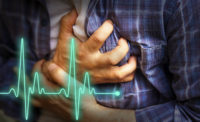Most U.S. employees are not prepared to handle cardiac emergencies in the workplace because they lack training in CPR and First Aid, according to new survey results from the American Heart Association (AHA), the world’s leading voluntary health organization devoted to fighting cardiovascular disease.
Two surveys reveal most workers do not have access to CPR and First Aid training, and half could not locate an automated external defibrillator (AED) at work – prompting the AHA to announce a new campaign to promote First Aid, CPR and AED training in the workplace as well as public access to AEDs.
Such training has the potential to save thousands of lives, considering there are 10,000 cardiac arrests in the workplace annually. Cardiac arrests occur when the heart suddenly stops beating, and survival chances outside the hospital can double or triple when CPR is immediately performed by a bystander.
More than 3,000 workers in various fields were surveyed between February and April 2017. In addition to 2,000 employees in corporate offices, hospitality, education and industry/labor, more than 1,000 safety managers in industries regulated by OSHA were also surveyed.
Some key findings from the employee study, commissioned by AHA and conducted by Edelman Intelligence:
- More than half (55 percent) cannot get First Aid or CPR+AED training from their employer – and even if employers do offer this training, it’s often either one or the other.
- Half of all U.S. workers (50 percent) cannot locate the AED at work. In the hospitality industry, that number rises to two-thirds (66 percent).
“The data suggests these untrained employees may be relying on their untrained peers in the event of an emergency, leaving employees with a false sense of security that someone in the workplace will be qualified and able to respond, when that is clearly not the case,” said Michael Kurz, MD, co-chair of the AHA’s Systems of Care Subcommittee and associate professor at the University of Alabama at Birmingham School of Medicine in the Department of Emergency Medicine.
Not surprisingly, the safety managers in OSHA-regulated industries see a need for more frequent training, although fully one-third said First Aid, CPR and AED training only became important and offered after an incident demonstrated the need. Other findings from the OSHA survey, commissioned by AHA and fielded by EHS Daily Advisor, include:
- One-third (33 percent) of safety managers said lives have been saved at home and at the workplace as a result of First Aid, CPR and AED training provided at work – and three-quarters (75 percent) said injuries or medical conditions have been treated in the workplace with this training.
- More than one-third (36 percent) of safety managers at OSHA-regulated businesses felt it would be valuable to offer training more frequently than every two years (the current requirement).
- Younger generations at OSHA-regulated industries were less likely to participate in First Aid, CPR and AED training, although the numbers are still high at over 44.5 percent. “This could be due to a decreased sense of risk among younger workers,” said Peter Fromm, MPH, RN, co-chair of the AHA Emergency Cardiac Care Subcommittee on Systems of Care and administrator at the South Nassau Communities Hospital Center for Cardiovascular Health.
“First Aid, CPR and AED training need to become part of a larger culture of safety within workplaces,” said Dr. Kurz. “We are certainly seeing higher public interest in this training, and our campaign calls upon decision makers in workplaces and popular public spaces such as arenas, fitness centers, hotels, and churches to place AEDs in the same locations as a fire extinguisher.”
Additionally, the survey results indicate more than 90 percent of employees would take First Aid and CPR+AED training if employers offered it, and most (70 percent) believe training would make them feel better prepared for emergencies. The AHA’s Workplace Safety Training Initiative urges organizations to proactively offer this training.
“We are disheartened that lifesaving First Aid and CPR+AED training is often only offered after a serious incident that demonstrated need,” said Fromm. “All businesses should be committed to proactively fostering a safe workplace environment, one that empowers people to take on a small social responsibility that can have a large community impact.”
Nancy Holland is a perfect example of this impact. She collapsed in January 2015 while dining at a restaurant in Kansas City, MO, and employee Richmond Carson responded immediately with CPR.
“Had Richmond not seen the value in being trained, I might not have survived,” says Holland. “I can’t stress enough how important and empowering these trainings and the availability of AEDs are for people.”
Of more than 350,000 out-of-hospital cardiac arrests that occur each year, over 100,000 happen outside the home. Holland now advocates training and public access to AEDs. The law firm at which her husband is a partner, Fisher Phillips, installed AEDs in all of the firm’s 32 offices nationwide while providing CPR+AED training to all 700 employees.
Source: The American Heart Association



